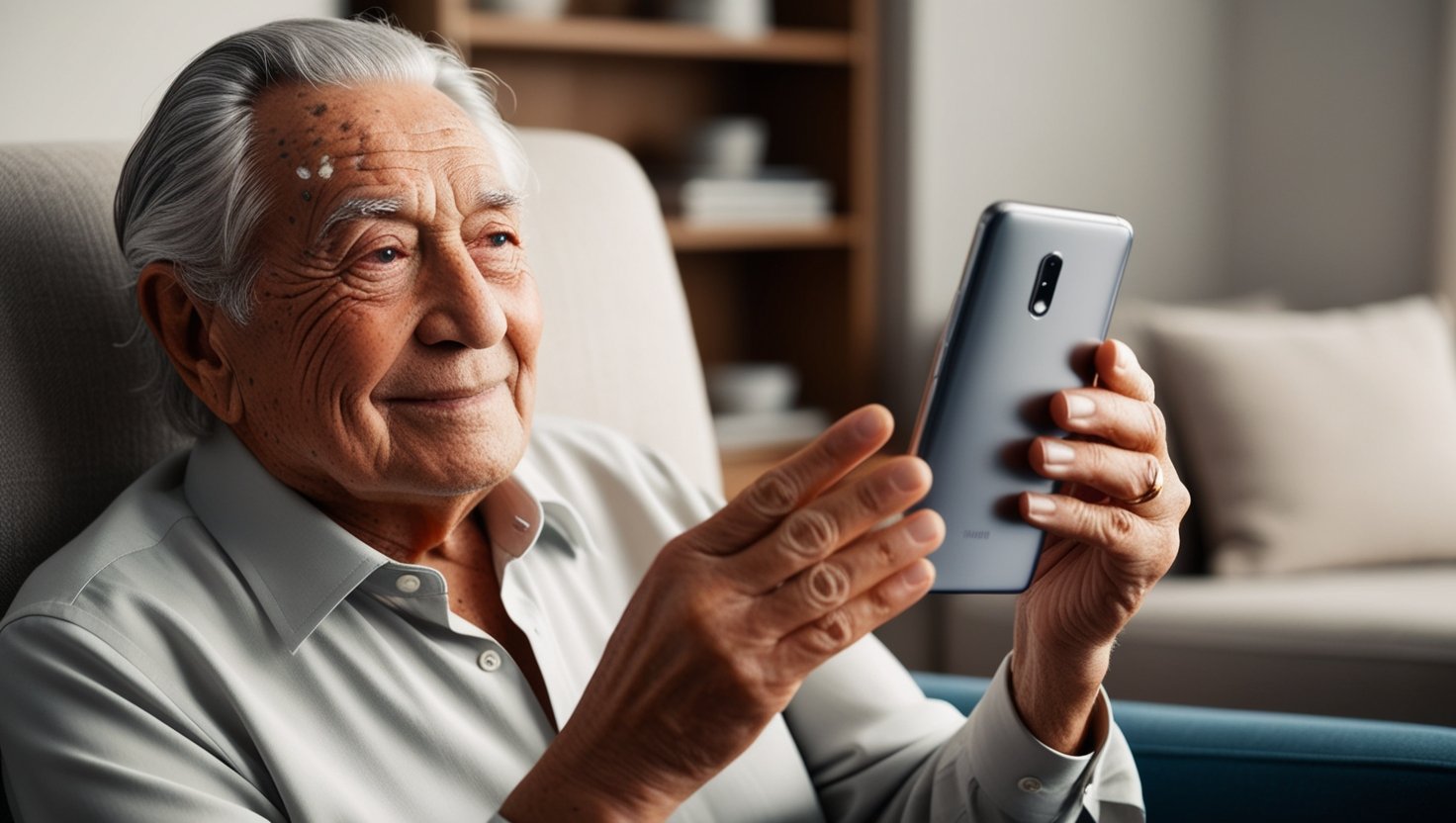In today’s fast-paced world, staying connected is not just a luxury; it’s vital—especially for our seniors. As technology continues to evolve, the importance of maintaining those cherished connections with family and friends only grows. Loneliness can be a silent struggle that many older adults face. But the truth is this: smartphones have moved beyond becoming mere gadgets. They are gateways to an enriched existence filled with laughter, support, and invaluable interactions.
Smartphones designed specifically for seniors offer user-friendly interfaces and features that prioritize empowerment over frustration. These compact devices have the power to turn everyday communication into vibrant conversations. With simplified controls and accessibility options tailored to various needs, smartphones position themselves as allies in aiding seniors to interact effortlessly. It’s time to showcase how embracing these advancements in technology can transform lives for seniors and everyone who cares.
SeniorThrive delves deeper into our guide on “Best Smartphones for Seniors,” prepare to discover how you can make informed choices that elevate connectivity for your loved ones. From features that accommodate eyesight changes to impressive battery life that keeps up with busy days, this article will redefine what it means to age boldly by harnessing modern communication tools. Together, let’s usher in an era where aging isn’t seen as a limitation but celebrated as an invitation for growth and connection!
Key Features to Look For in Smartphones for Seniors

When searching for the best smartphones for seniors, several key features can significantly enhance usability and ensure a positive experience. A large display with ample screen size and clear fonts is crucial. As eyesight tends to be one of the first senses to fade with age, having a device that presents information in a legible manner can make all the difference. Models like the Samsung Galaxy A32 exhibit a vibrant 6.4-inch display that’s easy on the eyes, while also allowing users to adjust font sizes and contrast settings to meet their preferences.
Another vital characteristic of user-friendly smartphones for older adults is a simplified user interface. Navigation should feel intuitive, using large icons and straightforward menus to reduce confusion or frustration. Brands such as Jitterbug lead by example with their ‘5Star’ button that allows users to connect quickly, along with an easily accessible home screen featuring enlarged icons for making calls or sending texts.
Lastly, built-in accessibility tools are essential in providing support for those who may have hearing or vision impairments. For instance, many smartphones equipped with iOS come preloaded with VoiceOver, allowing visually impaired users to have text read aloud or clarified through audio feedback. Likewise, Android devices often include TalkBack—a similar feature—to assist during navigation tasks. These tools not only empower seniors but can also boost their confidence in utilizing technology fully.
Incorporating these critical features when selecting smartphones designed for seniors opens doors to seamless communication and enhanced connections with family and friends. Empowering older adults through technology isn’t just about gadgetry; it’s about enriching lives and enabling independence without limitations.
Top Smartphone Options for Seniors
When it comes to choosing the best smartphones for seniors, several brands have stepped up with models specifically designed to meet their unique needs. Top contenders include Apple, Samsung, and AARP’s Tech Support-approved options. These smartphones are not insignificant plastic toys; they’re powerful devices that can keep older adults connected with family and friends while providing cutting-edge accessibility features in smartphones that enhance usability and independence.
Apple’s iPhone remains a leading choice among seniors, primarily due to its user-friendly interface and robust accessibility features. The large Retina display adjusts the size of text for easy reading, while ‘VoiceOver’ helps those with vision impairments navigate smoothly. The latest iPhone models also offer an option called “AssistiveTouch,” enabling users with mobility challenges to control their device effortlessly by using gestures or a simple touch on the screen. Additionally, seamless integration with other Apple products enhances connectivity within families who are already part of the Apple ecosystem.
For those who lean towards Android devices, the Samsung Galaxy series offers impressive options like the Galaxy A32 or Galaxy S21 FE. These smartphones boast larger displays and customizable settings that allow seniors to adjust font sizes and contrast levels easily—making it painlessly simple to read messages or view photos. Moreover, Galaxy phones feature ‘Easy Mode,’ simplifying screens by enlarging icons and minimizing clutter—all tailored for ease of use. With built-in health apps like Samsung Health, these devices also encourage seniors to be proactive about their wellness without feeling overwhelmed by technology.
Another accessible option is the Jitterbug Smart3 smartphone from Lively—a brand known for catering specifically to senior users. It provides an incredibly simplified interface that allows older adults to make calls, send texts, and access essential services. The phone even has a dedicated emergency button right on the home screen! This ensures peace of mind not just for seniors but also for family members worried about their loved ones’ safety—demonstrating how thoughtfully engineered technology can promote connection without overwhelming or frustrating users at any stage of life.
Benefits of Smart Technology for Older Adults
In a world that continuously evolves, it’s vital for older adults to stay connected with their family and friends. Smartphones for seniors have bridged a gap that once felt insurmountable. With applications like FaceTime, Zoom, or WhatsApp, seniors can enjoy real-time conversations. Imagine Grandma sharing her latest knitting project while we all simultaneously sip coffee—what was once just an idea is now entirely possible with the power of technology at our fingertips.
Beyond keeping in touch, smartphones also offer essential health monitoring features that empower seniors to take charge of their well-being. Many large display phones come equipped with health apps that track daily activities, remind users to take medications, or even monitor heart rates and blood sugar levels. For example, the Apple Health app allows users to consolidate key health information in one place. This enables easier communication between doctors and patients about critical metrics.
Entertainment options are another significant boon provided by smart technology. Whether it’s diving into the world of eBooks on Kindle App or playing games, older adults have limitless choices tailored to keep them engaged and stimulated. Furthermore, streaming services like Netflix or Hulu bring movies and shows right at their fingertips. Engaging in these hobbies not only combats feelings of loneliness but fosters continued learning and joy during retirement years.
Ultimately, embracing smartphones—and all the incredible features they offer—can significantly enhance the lives of older adults. These devices are stepping stones toward deeper connections with family members, better management of ongoing health conditions, and access to entertainment that reflects individual interests and pursuits. As we acknowledge this evolution in technology designed specifically for seniors’ needs, let’s redefine what aging looks like – vibrant and full of life!
User-Friendly Operating Systems
Choosing the right operating system is crucial for senior citizen mobile phones, as it plays a significant role in their overall usability and experience. The two primary contenders are iOS and Android. iOS offers a streamlined user interface that can be appealing to seniors who have less exposure to technology. Features like larger icons and straightforward navigation make it easier for seniors to access essential functions. Furthermore, Apple provides consistent updates that enhance security and functionality across all devices to ensure seniors are connected safely.
On the other hand, Android grants users more flexibility through its variety of device options—making it an attractive choice. Many manufacturers include specialized modes within their Android skins; this includes features like Easy Mode on Samsung devices or Senior Mode on various brands. These adaptations provide larger fonts, simplified menus, and customizable home screens. However, not all Android devices offer equally robust support or updates that’s why it is research on its kinds is important.
For catering specifically to senior users, various companies have developed systems focused directly on this demographic. Devices meant solely for older adults often incorporate voice-activated commands and large touch screens which strips away complications in using such. This approach empowers seniors to engage with technology without feeling overwhelmed by choices or intricate settings.
When considering updates and support available, remember that platforms such as iOS generally require little hands-on management. Meanwhile, staying informed about upcoming software improvements on Android devices will help ensure elders benefit from optimized experiences.
Tips for Teaching Seniors to Use Smartphones
Teaching seniors how to use smartphones is about unlocking a world of connectivity and support that can dramatically enrich their lives. It’s essential to approach the learning process with empathy, patience, and clear guidance. Start with the basics: making calls, sending texts, and downloading apps. Consider using familiar examples, such as showing them how to call a family member or send a message when they want to share a funny joke or ask for help. Keeping it personal makes the experience more relevant and motivating.
Break down each task into small, manageable steps. For example, when teaching how to make a call, start by demonstrating how to access the phone app. Guide them through typing in numbers or selecting contacts from their address book. Once they’ve grasped these basics, encourage practice sessions where they can repeat what they’ve learned without any pressure.
Learning technologies can feel overwhelming at first, but incorporating fun and ease into sessions goes a long way. For instance, you might spend an afternoon exploring photo apps together—showing seniors how easy it is to take pictures of loved ones during family gatherings or share snapshots of their latest hobbies on social media. By relating tasks back to things they care about, they can see the practical benefits behind these powerful smartphones for seniors.
Finally, instill an attitude of patience in yourself as well as your senior learner (and even other family members). Remind everyone involved that it’s perfectly normal for mistakes to happen; this isn’t just learning technology—it’s building new habits! Setting aside time for regular check-ins reinforces any newfound skills while keeping spirits high during learning breaks. Remember that each tiny leap forward is cause for celebration—you’re giving them tools that will nourish friendships and independence throughout their golden years!
Safety and Security Considerations
When it comes to smartphones for seniors, safety and security should always be top priorities. As the digital landscape evolves, so do potential threats. Establishing robust security features such as passcodes or biometric locks is essential for protecting sensitive personal information. Most modern smartphones offer a variety of ways to secure your device—from fingerprint sensors to facial recognition technology. For example, the Apple iPhone uses Face ID, while many Android devices feature fingerprint scanners. These biometric options not only enhance security but also make it easier for seniors with mobility challenges to access their phones without having to type complex passwords.
Equipping older adults with knowledge about scams targeting their demographic is equally important. Seniors can be more vulnerable to online fraud and phone scams that trick them into revealing sensitive information. A simplified user interface on these smartphones can help mitigate some risks by making it easier for users to identify unfamiliar calls or suspicious texts. Educating seniors on common scams can empower them to spot danger signs more quickly and avoid falling victim.
Additionally, consider tech-savvy family members as resources when doubts arise regarding any suspicious activity on a senior’s smartphone. Setting up options like an emergency contact list allows immediate outreach if something feels. Encourage open dialogues about technology so that these conversations become part of regular check-ins.
By taking proactive steps toward digital safety, seniors can engage confidently with technology while feeling secure in their newfound independence. With the right tools and knowledge in their hands, they are better equipped than ever to enjoy staying connected!
Accessories That Enhance Usability
When ensuring smartphones for seniors stay user-friendly, the right accessories can make all the difference. A protective case with grip and durability is essential. Many seniors have varying dexterity levels, so cases like the OtterBox Defender shield against drops and offer textured surfaces for easy holding. This added grip prevents slips during calls or scrolling, making it an excellent choice for seniors navigating accessible technology.
Styluses are another tool that enhances usability. Seniors may find tapping and swiping challenging due to small text or limited precision. A stylus like the Adonit Dash 3, slim and pen-like, enables precise touchscreen interactions without requiring much force. This effective accessory helps seniors navigate apps and messages comfortably, reducing frustration in their experience.
Larger screen protectors tailored for seniors significantly enhance usability. These protect against scratches and cracks and often have write-on/wipe-off features for jotting quick notes. Brands like Omoton offer protectors with clear illustrations, guiding users to utilize smartphone functions.
Incorporating thoughtful accessories into a senior’s smartphone experience empowers them to thrive in a digital world. Focusing on ease of use and functionality bridges generational gaps, helping seniors engage confidently with modern tools while feeling supported every step of the way.
Embrace the Power of Connection
In closing, we’ve shown how smartphones designed for seniors go beyond being mere tools. We’ve explored their essential features, like simplified interfaces and tailored accessibility options, making them highly user-friendly. With our guide to the best smartphones for seniors, you’re now equipped to choose a device that strengthens communication, supports health monitoring, and opens new avenues to explore your interests.
So, let’s ignite that spark of independence! Embracing technology doesn’t mean giving up; it means stepping boldly into this new chapter of life with the right tools. These smartphones are here to help you rewrite what aging looks like—stronger connections, improved well-being, and unfiltered joy in every moment. Remember: you’re not merely surviving in your golden years—you’re thriving! Contact us if you have any questions or you want to submit a tip.



